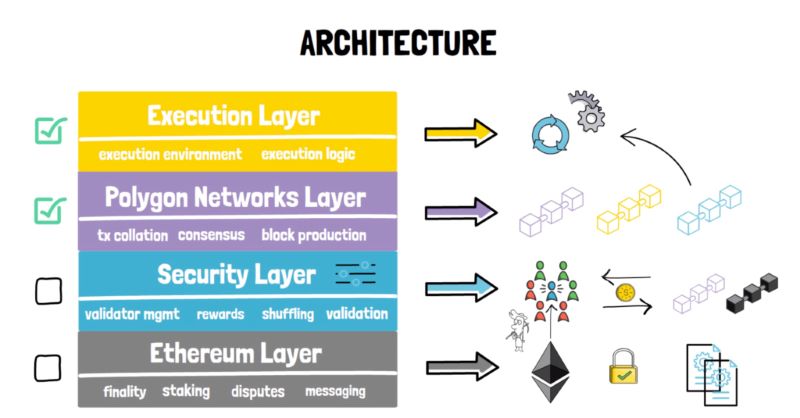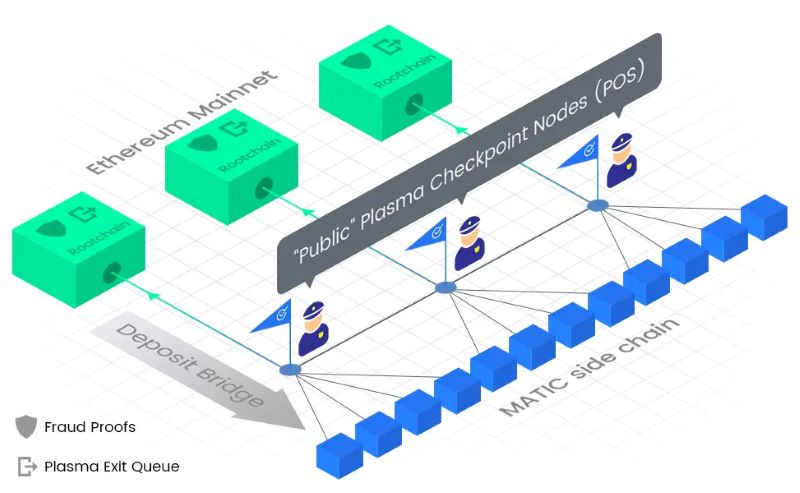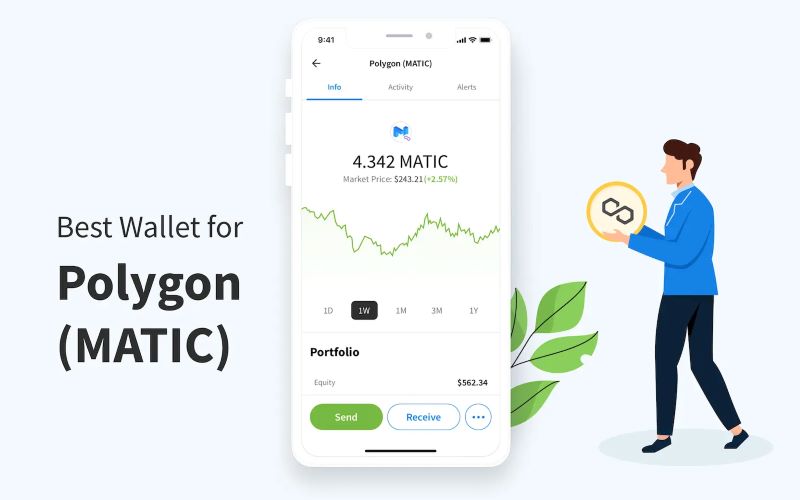What if Ethereum could handle millions of transactions per second? Discover Polygon, the groundbreaking scaling solution that’s making this a reality. Click to learn how Polygon is revolutionizing the world of decentralized applications.
What is Polygon?
The Polygon network is designed to tackle Ethereum’s scalability issues by processing transactions on a separate, Ethereum-compatible blockchain and then returning them to the main Ethereum blockchain. This offloading reduces network congestion, leading to faster transaction speeds and significantly lower transaction fees on Polygon.
Formerly known as Matic Network, Polygon provides a streamlined platform for blockchain projects to build on Ethereum. It empowers users to effortlessly interact with decentralized applications (dApps) without the worry of network congestion or high fees. This guide will delve into the intricacies of the Polygon network, its operational mechanisms, and its crucial role in making Ethereum more user-friendly and accessible.
Polygon founders
Polygon, initially known as Matic Network, was co-founded by Jaynti Kanani, Sandeep Nailwal, and Anurag Arjun in 2017. The project’s early development was supported by friends and family in Mumbai. As Polygon gained traction, it attracted global investors, raising substantial funding from individuals like Balaji Srinivasa and Mark Cuban. Jaynti Kanani, one of the co-founders, currently serves as the CEO of Polygon, leading the project’s continued growth and development.
How Polygon works
Polygon addresses Ethereum’s limited transaction processing capacity and high gas fees by employing a multi-faceted approach. It utilizes sidechains to process transactions off the main Ethereum blockchain, achieving a significantly higher throughput of 65,000 transactions per second compared to Ethereum’s 17. This drastically reduces transaction costs, making them more affordable for users.
Polygon offers a suite of scaling solutions, including plasma sidechains, proof-of-stake (PoS) bridges, zk rollups, and optimistic rollups. These solutions leverage zero-knowledge proofs, a cryptographic technique that verifies the validity of statements without revealing additional information.
Plasma sidechains enhance security and efficiency by running parallel to the main Ethereum blockchain. PoS bridges allow developers to build dApps on one platform while retaining the benefits of others. Zk rollups and optimistic rollups further optimize transaction processing by bundling transactions off-chain and submitting proofs to the main chain, reducing congestion and costs.
Polygon recognizes the trade-offs between different scaling solutions, such as security, sovereignty, fees, and speed. By providing a comprehensive suite of options, Polygon empowers developers to choose the most suitable scaling solution for their specific application, ultimately enhancing the overall performance and accessibility of the Ethereum ecosystem.
Why is Polygon suitable for Ethereum?
Polygon (MATIC) and Ethereum Layer 1
In the context of blockchain technology, “layer 1” refers to the main blockchain architecture, like Ethereum. On the other hand, “layer 2” represents a secondary network built on top of the layer 1 blockchain.
Layer 2 solutions like Polygon are designed to address the limitations of the underlying layer 1 blockchain, specifically enhancing its speed and efficiency. By handling transactions off the main chain and utilizing various scaling techniques, Polygon enables protocols already running on Ethereum to become faster, cheaper, and more user-friendly.
Using Polygon
Polygon offers a more accessible and cost-effective alternative to Ethereum’s auction-based transaction model, where rising gas fees often deter users during network congestion. By processing transactions off the main Ethereum blockchain, Polygon significantly reduces transaction costs and increases speed, making it a more attractive option for users and developers alike.
Furthermore, Polygon’s ambition extends beyond just improving transaction efficiency. It aims to connect all blockchains compatible with the Ethereum Virtual Machine (EVM), fostering a seamless ecosystem where developers can easily leverage the unique advantages of various platforms. This interoperability not only expands the possibilities for decentralized applications but also promotes innovation and collaboration within the blockchain community.
Ethereum 2.0 extinguishes the need for Polygon
While Ethereum 2.0 is a significant upgrade aimed at improving scalability, its capacity to handle the ever-growing demand from decentralized platforms and dApps remains limited. Increased usage could still lead to network congestion, high gas fees, and slower transaction times.
This is where Polygon comes in, acting as a supplementary scalability layer for Ethereum. Layer 2 solutions like Polygon enhance the user experience by further improving transaction speed and reducing costs.
Moreover, Polygon accelerates the implementation of Ethereum upgrades. Any improvements to Ethereum can be implemented faster and more efficiently on Polygon, ensuring users benefit from these advancements sooner.
Although Ethereum 2.0 is still under development, its founder, Vitalik Buterin, has acknowledged the “Trilemma challenge” of scalability. Polygon offers a practical solution by delivering some of the benefits of Eth2, such as increased speed, transparency, and lower costs, to users right now, rather than waiting for the full rollout of Eth2.
Layer two competitors
Polygon faces competition from other layer-2 solutions aiming to accelerate Ethereum transactions and alleviate network congestion. Notable rivals include Arbitrum and Optimism, both employing zk-proofs technology.
While Polygon currently boasts a substantial total value locked (TVL) of around $4 billion, indicating significant user engagement and asset commitment within its ecosystem, other competitors like Loopring also hold considerable TVL.
Despite this intense competition, all Ethereum layer-2 projects have the potential to benefit the blockchain ecosystem. Polygon’s notable investments in diverse zk-proofs technologies position it as a promising contender in addressing Ethereum’s scalability challenges, further solidifying its role in driving the future of decentralized applications.
What makes Polygon unique?
Polygon distinguishes itself in several ways:
Token Staking: Polygon is unique in allowing users to stake MATIC tokens directly on the Polygon blockchain, earning annual interest for their contribution to transaction validation.
Ambitious Vision: Polygon aims to scale the Ethereum blockchain to one billion users without compromising decentralization or security, envisioning an “Internet of Things” (IoT) for Ethereum.
Developer-Centric Approach: Unlike other layer 2 solutions, Polygon offers developers a comprehensive stack of scaling options on a single network, including zk-rollups, optimistic rollups, and Polygon Avail, a data availability blockchain for standalone chains and sidechains. This flexibility empowers developers to tailor solutions to their specific application needs.
Polygon SDK: The Polygon SDK enables developers to build standalone chains with their own security mechanisms and connect them to Ethereum through a dedicated PoS bridge, fostering a multichain ecosystem.
PoS Commit Chain with Checkpoints: Polygon’s PoS commit chain, also known as Polygon, is EVM-compatible and seamlessly integrates with Ethereum protocols. Unlike other EVM sidechains, Polygon commits checkpoints to Ethereum, ensuring the validity and security of all processed data on Polygon.
Proven Track Record: Polygon has processed over one billion transactions, demonstrating its reliability and scalability in real-world applications.
What is Polygon MATIC token used for?
MATIC, the native cryptocurrency token of Polygon, serves multiple purposes within the ecosystem. Primarily, it is used as a payment medium for transactions on the Plasma chains, which operate on a Proof of Stake (PoS) consensus mechanism. As more projects utilize Polygon’s scaling solutions, the demand for MATIC increases.
Beyond its transactional utility, MATIC functions as a governance token, granting holders voting rights on crucial decisions regarding the scaling solutions Polygon should adopt. This empowers the community to actively participate in shaping the future of Polygon’s product line, ensuring it aligns with their needs and preferences.
Where to buy the Polygon cryptocurrency
You can acquire Polygon (MATIC) tokens through various channels. Centralized exchanges like Coinbase and Binance offer a user-friendly experience for buying MATIC. Simply create an account, search for the MATIC token, and complete your purchase.
For more experienced users, decentralized exchanges (DEXs) like Uniswap provide an alternative. You can use wrapped Ethereum (wETH) to trade for MATIC on these platforms.
Once you have acquired MATIC tokens, store them securely in a Polygon wallet to manage and interact with your assets effectively.
Polygon wallets
Polygon wallets are digital wallets designed to facilitate various interactions with the Polygon network. These wallets allow users to send and receive cryptocurrency assets, stake MATIC tokens to earn rewards through validation, and utilize the Polygon bridge to transfer assets between different blockchains.
Polygon offers its own non-custodial web wallet, which gives users complete control over their private keys. However, it’s important to note that any wallet compatible with ERC-20 tokens, the standard used by MATIC, can be used to store and manage MATIC tokens.
Acquiring a Polygon wallet address
Acquiring a Polygon wallet address is a simple process. You can directly purchase and transfer MATIC tokens to any compatible address. For secure storage of your assets, consider using popular crypto wallets such as MetaMask or Ledger, a hardware wallet that can be connected to MetaMask for enhanced security.
Additionally, if you want to earn interest on your MATIC holdings, you can explore centralized lending platforms like Celsius and Nexo, which offer attractive annualized yields.
Polygon is not just a scaling solution; it’s a vision for a more accessible and user-friendly blockchain ecosystem. With its suite of powerful tools and technologies, Polygon is empowering developers and users alike to unleash the full potential of decentralized applications.
Dive deeper into the world of Polygon and stay informed about the latest advancements in blockchain scalability. Subscribe to the Blockchain Bulletin Weekly newsletter for in-depth analysis, expert insights, and exclusive content on Polygon and other cutting-edge blockchain technologies.



